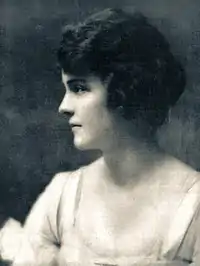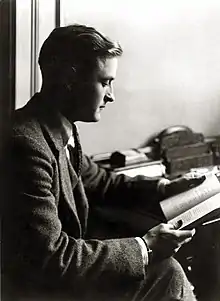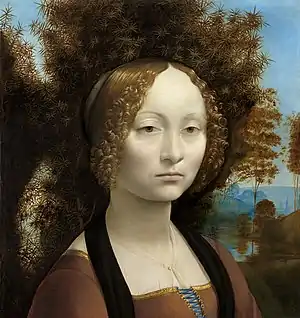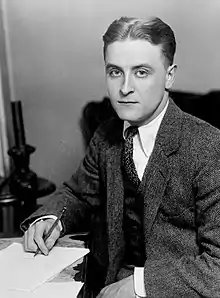Ginevra King
Ginevra King Pirie[2] (November 30, 1898 – December 13, 1980[2]) was an American socialite, debutante and heiress.[3] She was the inspiration for several characters in the novels and short stories of American novelist F. Scott Fitzgerald, in particular, the character of Daisy Buchanan in The Great Gatsby.[4][5][6][7] King and Fitzgerald shared a youthful romance from 1915 to 1917, but their relationship stagnated after King's father warned the impressionable young writer that "poor boys shouldn't think of marrying rich girls."[8] Scholars regard King as a "prototype of the aloof, upper-crust woman who is popular and rich and for [Fitzgerald] becomes an archetype" of "the American dream."[9]
Ginevra King | |
|---|---|
 A twenty-year-old King on the July 1918 cover of Town & Country magazine | |
| Born | November 30, 1898 |
| Died | December 13, 1980 (aged 82) |
| Nationality | American |
| Alma mater | Westover School (expelled)[1] |
| Occupation | Socialite |
| Spouse(s) | William Mitchell
(m. 1918–1937)John T. Pirie, Jr.
(m. 1942–1980) |
| Children | 3 |
King's first husband, William Mitchell—whom she later divorced after an unhappy marriage[10]—served as the model for Tom Buchanan in the same novel.[11] Mitchell would become the director of Texaco, one of the largest and most successful oil companies of the era.[12][13] King's second husband, John T. Pirie, Jr., was a business tycoon and owner of the Chicago department retailer Carson Pirie Scott & Company.[2][6]
Early life
King was born in Chicago in 1898, the daughter of socialite Ginevra Fuller[14] and successful Chicago financier Charles Garfield King.[15] Like her mother and her grandmother, she was named after Leonardo da Vinci's oil-on-wood painting Ginevra de' Benci.[16][8] Both sides of her family were extravagantly wealthy,[17] and they tended to prefer the company of "other prominent families in Chicago—the Swifts, Armours, Cudahys, Palmers, McCormicks, and Chatfield-Taylors. The children of these families went to schools and churches together and played with one another in Lake Forest during the summers."[15][3] Ginevra had two younger sisters, Marjorie and Barbara.[14]
Ginevra enjoyed a privileged upbringing and was feted in the Chicago social scene as a member of the elite "Big Four" Chicago debutantes during World War I.[3][18] She was raised at her family's sprawling estate in Lake Forest and was accustomed to "a life of tennis and polo ponies, private-school intrigues, and country-club flirtations."[19] Even as a young woman, King "had a clear sense of her family's wealth and position and, from an early age, a highly developed understanding of how social status worked."[20] Accordingly, she socialized in a small circle of her immediate "Big Four" friends which included Edith Cummings,[lower-alpha 1] Courtney Letts,[23] and Margaret Carry:
"The [Big Four] girls went to dances and house parties together, and they were seen as a foursome on the golf links and tennis courts at Onwentsia. If other girls were jealous, Ginevra and her three friends did not care. The Big Four was complete; it would admit no further members."[20][3]
As a young woman, King was reportedly "intensely competitive" and was loathe "to lose at anything—golf, tennis, or even basketball."[24] However, her intense competitiveness did not extend to her academic studies where she was "reasonably diligent about her schoolwork but wasn't terribly interested in it. She preferred athletics and parties, and she liked to sit up late talking with her [Big Four] friends."[25][10] She was "not much inclined towards introspection or self-analysis."[26]
In 1914, King's father sent Ginevra to Middlebury, Connecticut, to attend the Westover School, an "exclusive finishing school."[27] Her Westover schoolmates included such notable persons as Emily Anne Johnson (Poet), Isabel Stillman Rockefeller of the Rockefeller dynasty, as well as Margaret Livingston Bush and Mary Eleanor Bush,[lower-alpha 2] the aunts of President George H.W. Bush.[28][3] Most of Westover's attendees "were destined to be the wives of wealthy men; they would find fulfillment in social activities, in child-rearing, and, if they wished to, in helping the needy. This was a point much stressed at Westover; the girls were given a strong sense of responsibility and American-style noblesse oblige."[29][3]
Relationship with Fitzgerald

— Ginevra King, Letter to F. Scott Fitzgerald, 14 February 1915.[30]
Ginevra first met a young F. Scott Fitzgerald in St. Paul, Minnesota, on January 4, 1915,[31] while visiting Marie Hersey,[lower-alpha 3] her roommate from Westover.[32] They met at a sledding party on Summit Avenue. She was a 16-year-old at the Westover School and he was a 19-year-old at Princeton.[8] According to letters and diary entries, they both immediately became infatuated.[32][10]
After their first meeting, Fitzgerald began deluging Ginevra with voluminous correspondence which pleased her as "a girl's popularity was measured in part by which boys wrote to her and how many letters she received."[33] Against his wishes, Ginevra read Fitzgerald's intimate letters aloud to her Westover classmates for their amusement.[34][35] At one point, Ginevra asked for a photograph of him as she professed to recall only that he had "yellow hair and big blue eyes."[36][37]
They corresponded back and forth for months, and they exchanged numerous photographs. Over time, their letters became increasingly passionate.[10] Ginevra began having erotic dreams "about Scott" and "slept with his letters" in the hope "that dreams about him would come in the night."[38][39] Fitzgerald visited the King estate several times, and Ginevra wrote in her diary that she was "madly in love with him."[40] In March 1915, Fitzgerald asked Ginevra to be his consort for the Sophomore Prom—"the most important social event of the year at Princeton for members of his class"—but Ginevra's mother did not permit her to attend.[41]

In February-March 1916, Fitzgerald wrote a short story entitled "The Perfect Hour" in which he imagined Ginevra and he blissfully together at last, and he mailed the love story to her by post as a token of his affection.[42] Ginevra read the story to one of her other male suitors who nonetheless generously praised Fitzgerald's writing as excellent.[42] Despite Fitzgerald's frequent letters of affection, Ginevra nonetheless continued entertaining other suitors and, on May 22, 1916, she was expelled from Westover School for flirting with several young men from her dormitory window.[43][1] Mary Robbins Hillard,[44] the stern headmistress of Westover school,[44] declared King to be a "bold, bad hussy" and an "adventuress."[43][1] After threats by Ginevra's imperious father, Hillard later readmitted King to the school, but her father—irate at Westover's treatment of his beloved daughter—decided that she instead would complete her education at a New York finishing school.[43][1]
That summer, in August 1916, Fitzgerald again visited Ginevra at her family's Lake Forest villa but was purportedly told by her father, Charles G. King, that "poor boys shouldn't think of marrying rich girls."[8][45] (This line was later used in both the 1974 and 2013 film productions of The Great Gatsby.) The final meeting between Fitzgerald and King as a romantic couple occurred in November 1916 at Penn Station when Ginevra visited the Princeton campus for a Princeton-Yale football game.[46] In a candid interview decades after Fitzgerald's death, King recalled that she was secretly dating a Yale student in New York at this time,[46] and this complicated her final date with Fitzgerald who was unaware of the rival suitor awaiting her attentions:
"My girlfriend and I had made plans to meet some other, uh, friends. So we said good-bye [to Scott], 'we were going back to school, thanks so much.' Behind the huge pillars in the [train] station there were two guys waiting for us—Yale boys. We couldn't just walk out and leave them standing behind the pillars. Then we were scared to death we'd run into Scott and his friend. But we didn't."[46]
By January 1917, the romance between Fitzgerald and King was concluded. Fitzgerald later claimed that King had rejected him "with the most supreme boredom and indifference."[10] According to Fitzgerald biographer Arthur Mizener, Fitzgerald "remained devoted to Ginevra as long as she would allow him to," and she became his inspiration for the character of Isabelle Borgé, Amory Blaine's first love in This Side of Paradise,[47] for Daisy in The Great Gatsby, and several other characters in his novels and short stories.[9] Purportedly, "Fitzgerald was so smitten by King that for years he could not think of her without tears coming to his eyes."[10]
Marriages and later years

On July 15, 1918, King wrote to Fitzgerald, informing him of her engagement to William "Bill" Mitchell,[lower-alpha 4] the son of her father's business associate.[13] Their union "was something of an arranged marriage between two prominent Chicago families."[10] "To say I am the happiest girl on earth would be expressing it mildly," King wrote in her letter to Fitzgerald, "and I wish you knew Bill so that you could know how very lucky I am."[9] They were married on September 4, 1918,[48] and had three children, William, Charles, and Ginevra.[49] The union was purportedly unhappy.[10]
In 1937, Ginevra left Mitchell for businessman John T. Pirie, Jr., whom she met during an exclusive North Shore fox hunt.[6][10] Pirie was the heir presumptive to the Chicago department retailer Carson Pirie Scott & Company.[2][6] During the posh fox hunt, "a horse balked at a fence, throwing its rider, John Taylor Pirie Jr., to the ground in an unconscious heap, and then bolted across a field."[6] Ginevra "had been following closely behind Pirie, and it took only the sight of him lying on the grass motionless for her to leap to the ground."[6] She "hovered over him until the ambulance arrived, climbed into it after him, and remained with him" for the rest of her life.[6]
The next year, in 1938, Ginevra saw Fitzgerald for the last time in Hollywood, California.[23] "She was the first girl I ever loved and I have faithfully avoided seeing her up to this moment to keep the illusion perfect," Fitzgerald informed his daughter Scottie, shortly before the planned meeting. "I don't know whether I should go or not."[10] The reunion did not go well.[10][18] When Ginevra asked him which characters in his works were based upon her, Fitzgerald replied: "Which bitch do you think you are?"[10][8][18]
After Fitzgerald's death two years later in 1940, his daughter Scottie sent Ginevra a copy of her letters which Fitzgerald had kept with him until his death.[50] Reviewing her teenage letters to Fitzgerald, Ginevra commented in January 1951: "I managed to gag through them, although I was staggering with boredom at myself by the time I was through. Goodness, what a self-centered little ass I was!"[50]
King later founded the Ladies Guild of the American Cancer Society.[10] She died in 1980 at the age of 82 in Charleston, South Carolina.[2][6]
Literary legacy
— Judy Jones, Winter Dreams, December 1922.[51]
King exerted a great influence on Fitzgerald's writing, perhaps more so than his wife Zelda.[19] Scholar Maureen Corrigan notes that "because she's the one who got away, Ginevra—even more than Zelda—is the love who lodged like an irritant in Fitzgerald's imagination, producing the literary pearl that is Daisy Buchanan."[19]
Many years after their romance, Fitzgerald affectionately referred to Ginevra as "my first girl 18-20 whom I've used over and over [in my writing] and never forgotten."[19] His work abounds with characters modeled after and inspired by King, which include:[32]
- Isabelle Borgé in This Side of Paradise (1920)[5][9]
- Judy Jones in "Winter Dreams" (1922)[5][10][18]
- Paula Legendre in "The Rich Boy" (1924)[52]
- Daisy Buchanan in The Great Gatsby (1925)[5][9]
- Josephine Perry in The Basil and Josephine Stories (1928)[5][10]
- Their meeting in "Babes in the Woods," from the collection Bernice Bobs Her Hair and Other Stories, was reused in This Side of Paradise.
King is featured in the books The Perfect Hour by James L.W. West III and in a fictionalized form in Gatsby's Girl by Caroline Preston. The musical The Pursuit of Persephone tells the story of King's romance with Fitzgerald. She also appears in "West of Sunset" by Stewart O'Nan, a fictionalized account of Fitzgerald's final years, including his work in Hollywood and relationship with gossip columnist Sheilah Graham.
See also
References
Notes
- King's close friend, Edith Cummings, was an amateur golfer who inspired the spirited flapper character of Jordan Baker in Fitzgerald's The Great Gatsby.[21][22]
- In later decades, Margaret Livingston Bush (the sister of Prescott Sheldon Bush) would serve as a trustee of the Westover School in Middlebury, Connecticut.[28]
- Prior to meeting King, Fitzgerald had harbored "an innocent crush" on her roommate Marie Hersey whom he knew "during his youth in St. Paul, Minnesota."[10]
- William Mitchell would become the director of Texaco and the Continental Illinois National Bank.[13] He inspired the character of Tom Buchanan in The Great Gatsby.[11]
Citations
- The Scotsman 2003.
- Bleil 2008, p. 38.
- Diamond 2012.
- Borrelli 2013.
- Bleil 2008, p. 43.
- McKinney 2017.
- Bruccoli 2002, pp. 53-59.
- Smith 2003.
- Stepanov 2003.
- Noden 2003.
- Bruccoli 2002, p. 86.
- Mitchell Obituary 1987.
- Chicago Tribune Staff 1987.
- 1910 United States Census
- West 2005, p. 6.
- West 2005, p. 8.
- West 2005, pp. 6-10.
- Corrigan 2014, p. 59.
- Corrigan 2014, p. 58.
- West 2005, pp. 8-9.
- Bleil 2008, p. 230.
- Bruccoli 2002, p. 211.
- Bleil 2008, p. 32.
- West 2005, p. 9.
- West 2005, pp. 9-10.
- West 2005, p. 10.
- West 2005, p. 11.
- Margaret Bush Obituary 1993.
- West 2005, pp. 11-12.
- Bleil 2008, pp. 65-66.
- West 2005, p. 21.
- Mizener 1972.
- West 2005, p. 26.
- West 2005, pp. 26-27.
- Bleil 2008, pp. 176-177.
- Bleil 2008, p. 54.
- West 2005, p. 28.
- Bleil 2008, p. 107.
- West 2005, p. 33.
- West 2005, p. 35.
- West 2005, pp. 39-40.
- West 2005, p. 50.
- West 2005, p. 49.
- Dallas 1944.
- Corrigan 2014, p. 61.
- West 2005, pp. 62-64.
- Bruccoli 2002, pp. 123-124.
- Cook County, Illinois Marriage Indexes, 1912-1942
- 1930 United States Census
- Bleil 2008, p. 33.
- West 2005, Appendix 4: Winter Dreams.
- Corrigan 2014, p. 60.
Bibliography
- Bleil, Robert Russell (December 2008). "Temporarily Devotedly Yours: The Letters of Ginevra King to F. Scott Fizgerald". Pennsylvania State University. Retrieved November 29, 2019. Cite journal requires
|journal=(help)CS1 maint: ref=harv (link) - Borrelli, Christopher (May 7, 2013). "Revisiting Ginevra King, The Lake Forest Woman Who Inspired 'Gatsby'". The Chicago Tribune. Retrieved November 29, 2019.CS1 maint: ref=harv (link)
- Bruccoli, Matthew Joseph (2002). Some Sort of Epic Grandeur: The Life of F. Scott Fitzgerald (2nd rev. ed.). Columbia, South Carolina: University of South Carolina Press. pp. 123–124. ISBN 1-57003-455-9.CS1 maint: ref=harv (link)
- Chicago Tribune Staff (March 25, 1987). "William H. Mitchell, 92, Banker, Philanthropist". The Chicago Tribune. Retrieved November 29, 2019.CS1 maint: ref=harv (link)
- Corrigan, Maureen (September 9, 2014). So We Read On: How The Great Gatsby Came to Be and Why It Endures. Little, Brown and Company. ISBN 978-0-316-23008-7.CS1 maint: ref=harv (link)
- Dallas, John T. (1944). Mary Robbins Hillard. Concord, New Hampshire: Rumford Press. Retrieved January 28, 2020 – via Internet Archive.CS1 maint: ref=harv (link)
- Diamond, Jason (December 25, 2012). "Where Daisy Buchanan Lived". The Paris Review. Retrieved January 3, 2020.CS1 maint: ref=harv (link)
- "Margaret Bush Clement; Bush's Aunt, 93". The New York Times. June 2, 1993. p. 20. Retrieved January 2, 2020.
- McKinney, Megan (December 10, 2017). "The Other Pirie Heirs". Classic Chicago Magazine. Retrieved November 29, 2019.CS1 maint: ref=harv (link)
- Mizener, Arthur (1972). Scott Fitzgerald and His World. New York: G.P. Putnam's Sons. ISBN 978-0-500-13040-7.CS1 maint: ref=harv (link)
- New York Times Staff (March 29, 1987). "William H. Mitchell Obituary". The New York Times. p. 30. Retrieved January 3, 2020.
- Noden, Merrell (November 5, 2003). "Fitzgerald's First Love". Princeton Alumni Weekly. Retrieved November 29, 2019.CS1 maint: ref=harv (link)
- Smith, Dinitia (September 8, 2003). "Love Notes Drenched in Moonlight; Hints of Future Novels in Letters To Fitzgerald". The New York Times. Retrieved November 29, 2019.CS1 maint: ref=harv (link)
- Stepanov, Renata (September 15, 2003). "Family of Fitzgerald's Lover Donates Correspondence". The Daily Princetonian. Archived from the original on October 4, 2003. Retrieved November 29, 2019.CS1 maint: ref=harv (link)
- "Tender is the Slight". The Scotsman. Edinburgh. September 22, 2003. Retrieved January 2, 2020.
- West, James L.W. (2005). The Perfect Hour: The Romance of F. Scott Fitzgerald and Ginevra King, His First Love. New York: Random House. ISBN 978-1-4000-6308-6.CS1 maint: ref=harv (link)
External links
| Wikimedia Commons has media related to Ginevra King. |
- Stevens, Ruth. Before Zelda, There Was Ginevra — Princeton Weekly Bulletin — September 7, 2003
- Preston, Caroline. Excerpt: Gatsby's Girl — NPR — Weekend Edition Sunday, May 21, 2006

